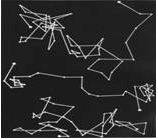Test: Properties of Colloids (Old NCERT) - JEE MCQ
20 Questions MCQ Test - Test: Properties of Colloids (Old NCERT)
When colloids are subjected to an electrical field particles move towards an electrode and precipitate. Name the process.
Which property is represented by the following figure;

Which law is represented by the following expression?
For a positive colloid the order of precipitation is : Phosphate ion>sulphate ion >chloride ion.
Which substance is added to water containing suspended impurities to coagulate the suspended impurities and make water fit for drinking purposes.
The simplest way to check whether a system is a colloid is by using:
Which method cannot be used for the coagulation of the lyophobic sol?
Lyophilic colloids that shows the property of protecting lyophobic colloids are also called as:
Which of the following forms a colloidal solution in water?
The factors which are responsible for the stability of lyophilic sols are:
Which property of colloids is applied in rubber plating & sewage disposal?
In Tyndall effect the colloidally suspended particles:
Ferric hydroxide is a negative sol, which of the following electrolyte will coagulate it most:
What is aggregation of colloidal particles into insoluble precipitate by addition of some suitable electrolyte called?
A fresh precipitate can be transformed into colloidal sol by:
Which statement describes coagulation value?
Which electrolyte will precipitate a negatively charged colloids (As2S3 sol) to a greater extend?
The process in which colloid is placed inside a bag of semi permeable membrane like cellophane or parchment paper which permits ions and not colloids to pass through, is called as:
Which of the following will have the highest coagulating power for As2S3 colloids?
What is scattering of light by mist on head light of vehicles called?














